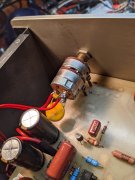This fancy new table, on it's way from Japan to me, runs at 100VAC of course.
Here in 'murica we use 120VAC.
Transformer secondary output is 12VAC (0.6Amp) See attached schematic.
At 120VAC input, secondary output will be 14.4VAC
To drop that to 12VAC, I need a resistor (or two?). My calculations come up with 4 ohm, 2 watt rated.
My question is, since we are dealing with AC, should I have two resistors, one for each secondary leg coming off the transformer, or will one leg resistor do it?
Further- if I should add the resistor to both legs, should they both be 4 ohms, or should I use 2 ohms per leg (I doubt this, but this is where I need help)
And maybe I got it all screwed up.
Check please!
Thanks in advance!
Here in 'murica we use 120VAC.
Transformer secondary output is 12VAC (0.6Amp) See attached schematic.
At 120VAC input, secondary output will be 14.4VAC
To drop that to 12VAC, I need a resistor (or two?). My calculations come up with 4 ohm, 2 watt rated.
My question is, since we are dealing with AC, should I have two resistors, one for each secondary leg coming off the transformer, or will one leg resistor do it?
Further- if I should add the resistor to both legs, should they both be 4 ohms, or should I use 2 ohms per leg (I doubt this, but this is where I need help)
And maybe I got it all screwed up.
Check please!
Thanks in advance!
Attachments
-
197.1 KB Views: 13

